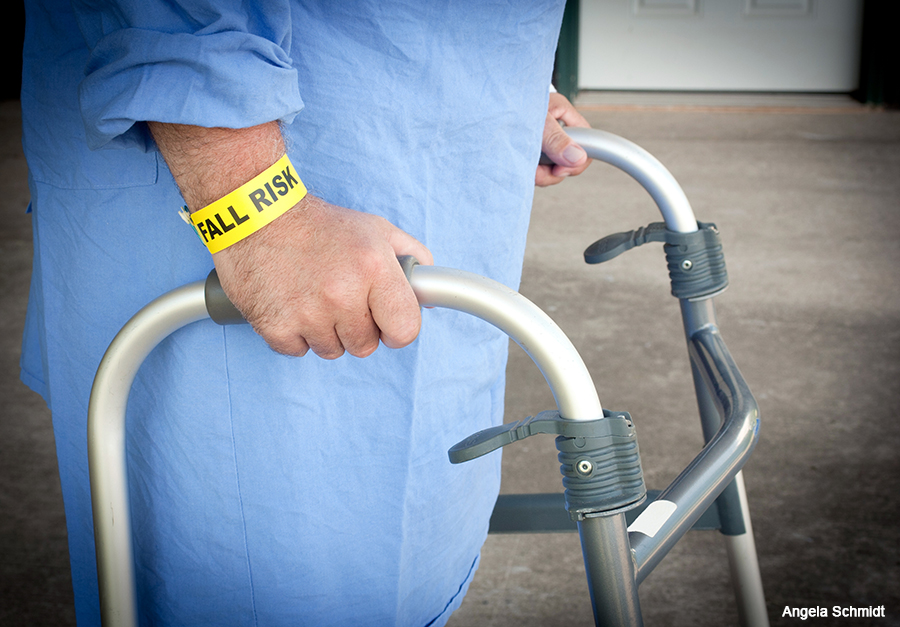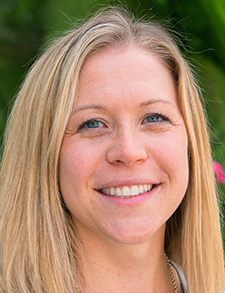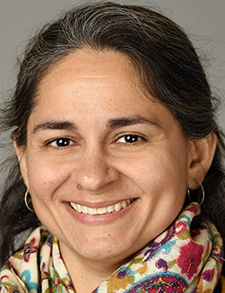 An estimated 700,000 to 1,000,000 falls occur in hospitalized patients in this country every year, with one-quarter to one-third of the falls leading to injuries. At least 10% of those are serious injuries—resulting in fractures, head trauma, and even an estimated 11,000 deaths.1 The Agency for Healthcare Research and Quality (AHRQ) calls falls “a common and devastating complication of hospital care, particularly in elderly patients.”2 The Joint Commission considers them sentinel events, and the Centers for Medicare and Medicaid Services does not reimburse hospitals for the additional costs of care associated with a patient’s fall.
An estimated 700,000 to 1,000,000 falls occur in hospitalized patients in this country every year, with one-quarter to one-third of the falls leading to injuries. At least 10% of those are serious injuries—resulting in fractures, head trauma, and even an estimated 11,000 deaths.1 The Agency for Healthcare Research and Quality (AHRQ) calls falls “a common and devastating complication of hospital care, particularly in elderly patients.”2 The Joint Commission considers them sentinel events, and the Centers for Medicare and Medicaid Services does not reimburse hospitals for the additional costs of care associated with a patient’s fall.

Dr. Raffel
“I have seen, even just in the time I have been practicing and thinking about safety over the past five years, subdural hematomas, hip fractures, and a vision-threatening globe rupture,” said Katie Raffel, MD, FHM, a hospitalist at UCHealth University of Colorado Hospital, and assistant professor of medicine at the University of Colorado, both in Aurora, Colo. “Any type of injury associated with a fall can also be associated with prolonged hospitalization and decreased quality of life.”
Hospitalists may feel that preventing falls lies outside their job responsibilities, but if they are leading the way in creating a culture of quality and safety within their institutions, then this common adverse event on their watch is an obvious target for their leadership, said Dr. Raffel, who co-directs University of Colorado Health’s acute care of the elderly (ACE) unit and supports the hospital’s fall reduction efforts.
The hospitalist’s role in preventing falls is twofold, she added. “There’s the action you take at the bedside, with the patient, and then the action you are taking as a systems leader—someone who’s working to shape the quality of care in the hospital.” For care at the bedside, prescribing and deprescribing among older patients may be guided by the Beers Criteria for potentially inappropriate medication use in older adults, developed by the American Geriatrics Society.
“On our ACE service, we huddle daily as an interprofessional team with care management, social work, nutrition, pharmacy, nursing—a robust team reviewing all the patients,” Dr. Raffel said. A pharmacist with geriatric training has a defined role in reviewing the list of high-risk medications prescribed for each patient.
Begin with assessment
Prevention begins with assessing each patient’s risk for falling, although among existing clinical prediction tools, the supporting evidence is not strong, Dr. Raffel said. Fall-assessment tools include the Johns Hopkins Fall Risk Assessment Tool, the Morse Fall Scale, and AHRQ’s STRATIFY Scale for identifying fall risk factors.
Using standard risk tools, most patients on medicine units cared for by hospitalists will be considered at high fall risk, she said. “So instead of having a laser focus on the patients who really need the most attention, planning, and response from the team, we have a blunt model that says everybody’s at high risk.”
Dr. Raffel’s group is now drawing on internal falls data to develop a homegrown “fall with injury risk prediction model.” They hope to narrow down the proportion of patients identified as at risk for falls with injury. “That way, we can tailor our interventions to a smaller subset of our population.”

Dr. Kara
For Areeba Kara, MD, MS, MBBS, SFHM, hospitalist and associate professor of medicine at Indiana University School of Medicine in Indianapolis, falls are a particular problem in the hospital because patients are away from their homes, acutely unwell, and experiencing sleep deprivation and polypharmacy. “These are disorienting experiences and the physical space and layout of where you are is completely different from home. So, your universe has changed, and you are not as steady as you thought you were,” Dr. Kara said.
Hospitalists have an important role because the causes of falls often are a culmination of multiple events, she said. “A hospitalist may not have control over the existing frailty a patient brings to the hospital. But we do have a responsibility and can pay attention to things like what medications we prescribe. Are these likely to make a patient orthostatic—meaning their blood pressure falls when they stand up? Are we prescribing their diuretic at 7 p.m. so that they’re going to need to get up and go to the bathroom in the middle of the night when it’s dark and they’re disoriented?”
Dr. Kara worked with a team of clinical nurse specialists at Indiana University, including Bethany Radecki and Staci Reynolds, to better understand the issue of patient falls and what can be done about it.3 “We interviewed patients and asked those who were identified as being at high fall risk what they felt about all this, what we’re doing, what’s working, what’s not working. We found that every patient has a sense of who they are and what they can do (for themselves) and their independence. Unfortunately, the things we do to try to prevent falls interfere with that sense.”
Their conclusion from the research: What’s more likely to work is a patient-centered plan that is co-created with patients and with the families at their bedside, Dr. Kara said. “I think for us to be successful, this is not something we do to our patients but something we create as a safety plan with our patients. Because not being able to get up and self-toilet strips patients of their dignity. That’s not what we mean to do, but that is how it is perceived,” Dr. Kara said.
The hospitalized patient may have a different sense than the clinician of what they are able to do, which requires a meeting of the minds and perhaps a practical demonstration of their abilities, she said. “‘Show me that you can walk safely. I’ll be here to catch you.’ And you have to do this repeatedly because things change hour to hour in the hospital and patients may become weaker.”
Techniques and approaches
The medical literature is full of studies about the various approaches to inpatient falls prevention. A meta-analysis in Age and Ageing from last year found that staff and patient education was the only intervention that resulted in a documented reduction in falls, although multi-factorial interventions had a tendency toward a positive impact.4 Various systems for addressing falls include the Center for Disease Control and Prevention’s STEADI Initiative and AHRQ’s Fall TIPS.5,6
Devices, techniques, and measures taken to reduce hospital falls include the following, although the evidence for their efficacy is not strong, according to Dr. Raffel:
- Changing the physical environment and setup of the room, including non-slip flooring material, lowering the bed height, opening windows, using whiteboard postings to spell out the patient’s fall risk and the medical plan for it, and having clear sightlines from nursing staff to patients
- Bed alarms to alert staff when the patient tries to get out of bed, including “smart socks” containing pressure sensors that can detect when a patient is trying to stand up
- Attention to issues such as optimal nutrition, hydration, and vitamin D dosing7
- Physical therapy, rehabilitation, and exercise
- Allowing patients to sleep through the night
- Non-pharmaceutical approaches such as reorienting, redirecting, and verbal de-escalation
- Patient sitters, also called patient safety assistants or companions, are non-clinical staff or volunteers who “sit” with, observe, and talk to patients who are at particular risk for getting up impulsively or otherwise harming themselves
The impact of sitters has not been well studied, Dr. Raffel said, and hospitals may struggle with this scarce human resource and its cost. Alternatively, a virtual sitter, with access to two-way cameras and microphones, can observe multiple patients at the same time. A study of this novel patient-observer technology in NEJM Catalyst suggests that it achieved a 40% reduction in fall-related injuries.8 According to Becker’s Health IT, Community Health Systems in Tennessee reported a 76% drop in falls at some of its hospitals from this approach.9
“We have expanded our virtual sitter capacity recently,” Dr. Raffel said. “We have an offsite virtual health center where one person with a big track board in front of them can monitor up to 20 patients at once.”
Mobilization is key
Colorado has been a leader in innovative falls management. But Dr. Raffel said it is still a work in progress. With the COVID-19 pandemic, post-pandemic staff departures, and increased complexity of acute patients in recent years, its fall rates have actually gone up.
A lot of the interventions to prevent falls can also restrict the patient’s mobility and may perversely delay recovery from the acute causes of the hospitalization. At UCHealth, mobilization is measured at every shift, using AM-PAC (the Activity Measure for Post-Acute Care) along with the JH-HLM (Johns Hopkins Highest Level of Mobility) Scale, “which tells us the highest mobility you’re capable of and the highest mobility you’ve achieved today. It gives us the opportunity to look at patients who have been on our fall precautions to get a sense for how much loss of function they have actually experienced,” Dr. Raffel said.
“Some of the innovative work we’ve done recently has been around expanding the team that helps mobilize hospitalized patients—beyond the physical therapist. Now on our medicine units, we have a team member who is called a mobility technician—a lot like a physical therapy extender, whose entire workday is just mobilizing patients out of their hospital beds.” The mobility tech can work with up to 18 patients a day, having a pretty profound impact without costing as much, Dr. Raffel said.
The team is trying to get a sense of how best to incorporate mobility techs into the team and which patients they should be targeting. “We’re also enhancing our certified nurse assistant staffing ratios and giving them a larger role in promoting activities of daily living—making sure patients are getting out of bed, getting mobilized, getting to the bathroom or shower,” Dr. Raffel said.
“If I had the podium, I’d tell hospitalists they need to be better partners in this work—because this is our most common adverse event, one that can lead to really major consequences for our patients. While we’ve done a lot of study in reducing falls among the geriatric population in the ambulatory setting, more rigorous study needs to happen in the inpatient setting. The science is just not there yet,” she said.
“I feel that’s where hospitalists can really contribute to achieving a more high-fidelity understanding of what works and what doesn’t work. We’re partners with our nursing colleagues. We can bring a more evidence-based medicine approach that may support the critical thinking of the institution.”
Larry Beresford is an Oakland, Calif.-based freelance medical journalist, specialist in hospice and palliative care, and long-time contributor to The Hospitalist.
References
- LeLaurin JH, Shorr RI. Preventing falls in hospitalized patients: State of the science. Clin Geriatr Med. 2019;35(2):273-83.
- Agency for Healthcare Research and Quality. Falls. AHRQ website. https://psnet.ahrq.gov/primer/falls#:~:text=Falls%20are%20a%20common%20and,hospitalized%20patients%20fall%20each%20year. Published September 7, 2019. Accessed December 2, 2023.
- Radecki B, Reynolds S, Kara A. Inpatient fall prevention from the patient’s perspective: A qualitative study. Appl Nurs Res. 2018;43:114-9.
- Morris ME, et al. Interventions to reduce falls in hospitals: A systematic review and meta-analysis. Age Ageing. 2022;51(5): doi: 10.1093/ageing/afac077.
- Lee R. The CDC’s STEADI initiative: promoting older adult health and independence through fall prevention. Am Fam Physician. 2017;96(4):220-1.
- Dykes PC, et al. Cost of inpatient falls and cost-benefit analysis of implementation of an evidence-based fall prevention program. JAMA Health Forum. 2023;4(1):e225125. doi: 10.1001/jamahealthforum.2022.5125.
- Chua GT, Wong RY. Association between vitamin D Dosing regimen and fall prevention in long-term care seniors. Can Geriatr J. 2011;14(4):93-9.
- Westle MB, et al. reducing inpatient falls and injury rates by integrating new technology with workflow redesign. NEJM Catalyst. 2019. doi:10.1056/CAT.19.0659.
- Bruce G. Community Health Systems to expand virtual sitting to 29 hospitals. Becker’s Health IT website. https://www.beckershospitalreview.com/digital-health/community-health-systems-to-expand-virtual-sitting-to-29-hospitals.html. Published Aug. 29, 2023. Accessed December 2, 2023.
These are great ideas, but many only work in theory. Rehabilitation facilities, which are the ultimate disposition locale for many of these patients (far more so than other cohorts of patients we care for as hospitalists), will not accept patients if they have an in-person or virtual sitter. They usually require 24 hours without either, sometimes 48 hours. This leads to extended lengths of stay, which can lead to more falls, as well as the normal host of hospital-acquired complications. Additionally, video sitters can be very disorienting to already confused patients. “Why is this robot-looking-thing talking to me?” We need fall solutions that involves more mobility and reorientation rather than more monitoring.